Critical Analysis: Australian Humanitarian Aid in Myanmar (2014-2017)
VerifiedAdded on 2021/06/14
|11
|3669
|93
Report
AI Summary
This report presents a critical evaluation of Australian humanitarian assistance provided to Myanmar between 2014 and 2017, focusing on the Rakhine and Kachin states. The analysis assesses the relevance, efficiency, and effectiveness of aid programs in response to ongoing communal tensions, displacement, and the needs of vulnerable populations. The report details the methodology used, including quantitative and qualitative approaches such as desk reviews, interviews with key stakeholders, and group discussions with affected communities. It also examines the underlying values and principles guiding the humanitarian efforts, the involvement of various organizations like UNHCR, BRAC, and WFP, and the criteria used to evaluate the aid's impact, referencing the International Federation of Red Cross and Red Crescent Societies (IFRC) framework. The findings highlight the challenges faced by Myanmar, the data collection processes, and the limitations encountered during the evaluation, offering insights into the strengths and areas for improvement in future humanitarian interventions.
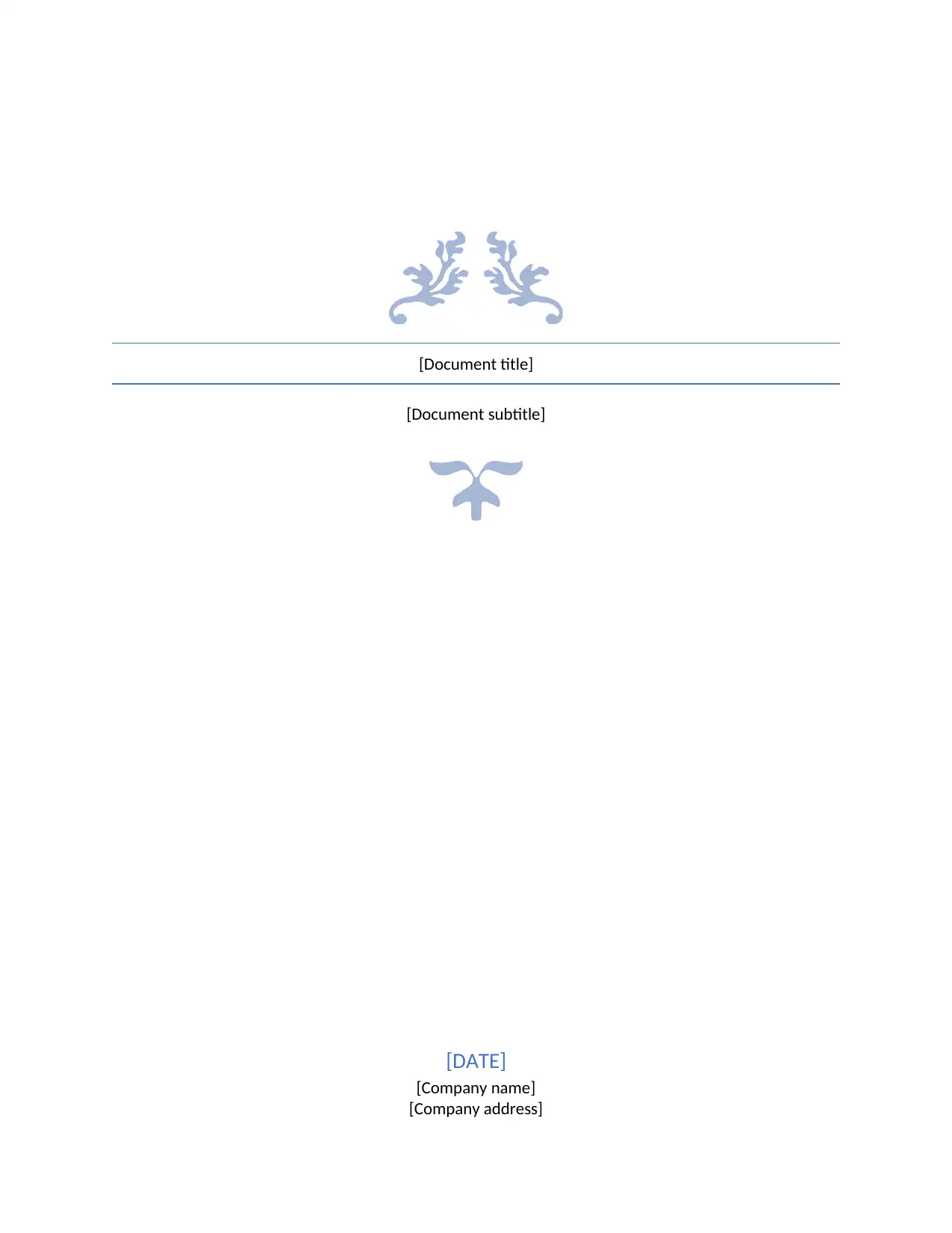
[Document title]
[Document subtitle]
[DATE]
[Company name]
[Company address]
[Document subtitle]
[DATE]
[Company name]
[Company address]
Paraphrase This Document
Need a fresh take? Get an instant paraphrase of this document with our AI Paraphraser
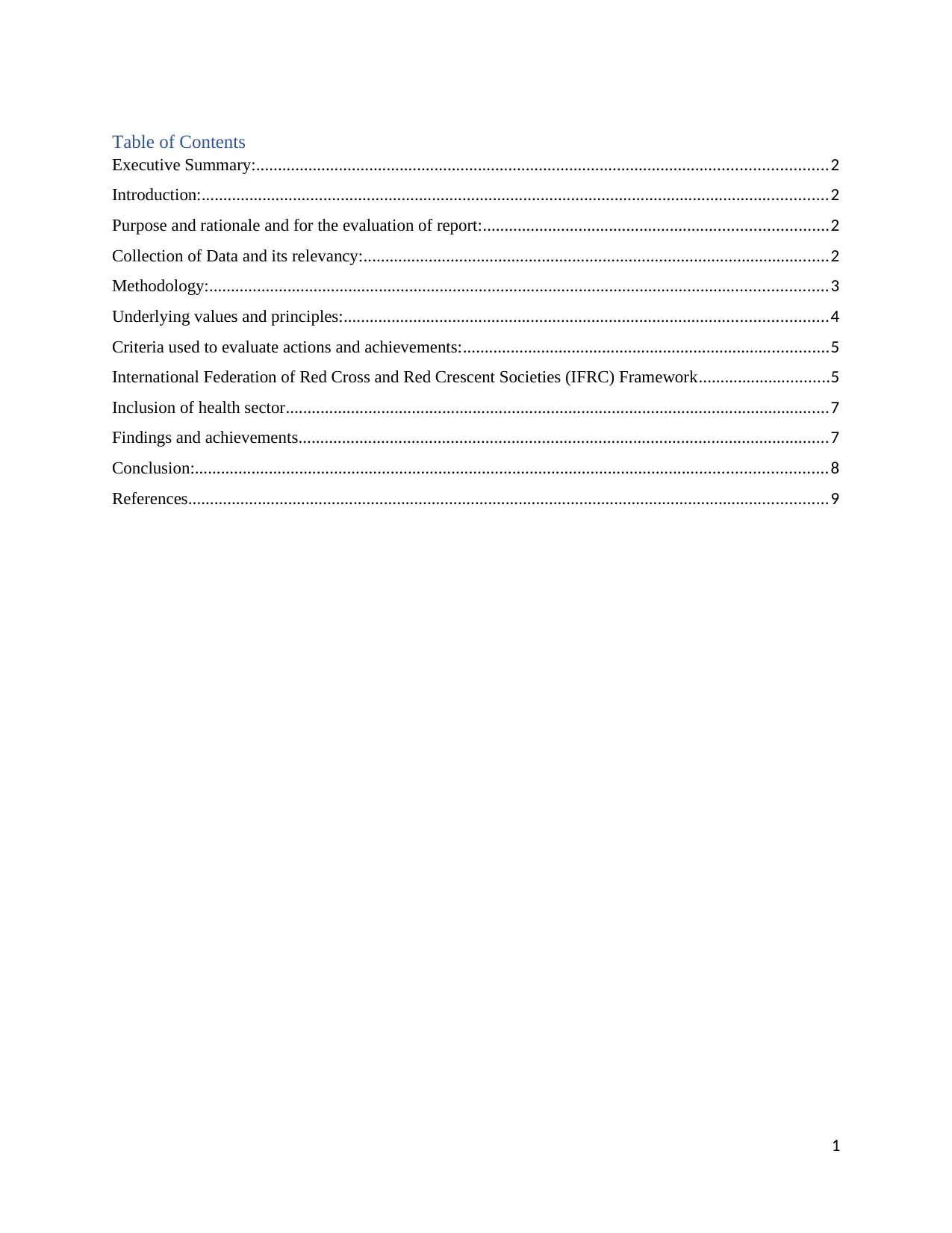
Table of Contents
Executive Summary:...................................................................................................................................2
Introduction:................................................................................................................................................2
Purpose and rationale and for the evaluation of report:...............................................................................2
Collection of Data and its relevancy:...........................................................................................................2
Methodology:..............................................................................................................................................3
Underlying values and principles:...............................................................................................................4
Criteria used to evaluate actions and achievements:....................................................................................5
International Federation of Red Cross and Red Crescent Societies (IFRC) Framework..............................5
Inclusion of health sector.............................................................................................................................7
Findings and achievements..........................................................................................................................7
Conclusion:.................................................................................................................................................8
References...................................................................................................................................................9
1
Executive Summary:...................................................................................................................................2
Introduction:................................................................................................................................................2
Purpose and rationale and for the evaluation of report:...............................................................................2
Collection of Data and its relevancy:...........................................................................................................2
Methodology:..............................................................................................................................................3
Underlying values and principles:...............................................................................................................4
Criteria used to evaluate actions and achievements:....................................................................................5
International Federation of Red Cross and Red Crescent Societies (IFRC) Framework..............................5
Inclusion of health sector.............................................................................................................................7
Findings and achievements..........................................................................................................................7
Conclusion:.................................................................................................................................................8
References...................................................................................................................................................9
1
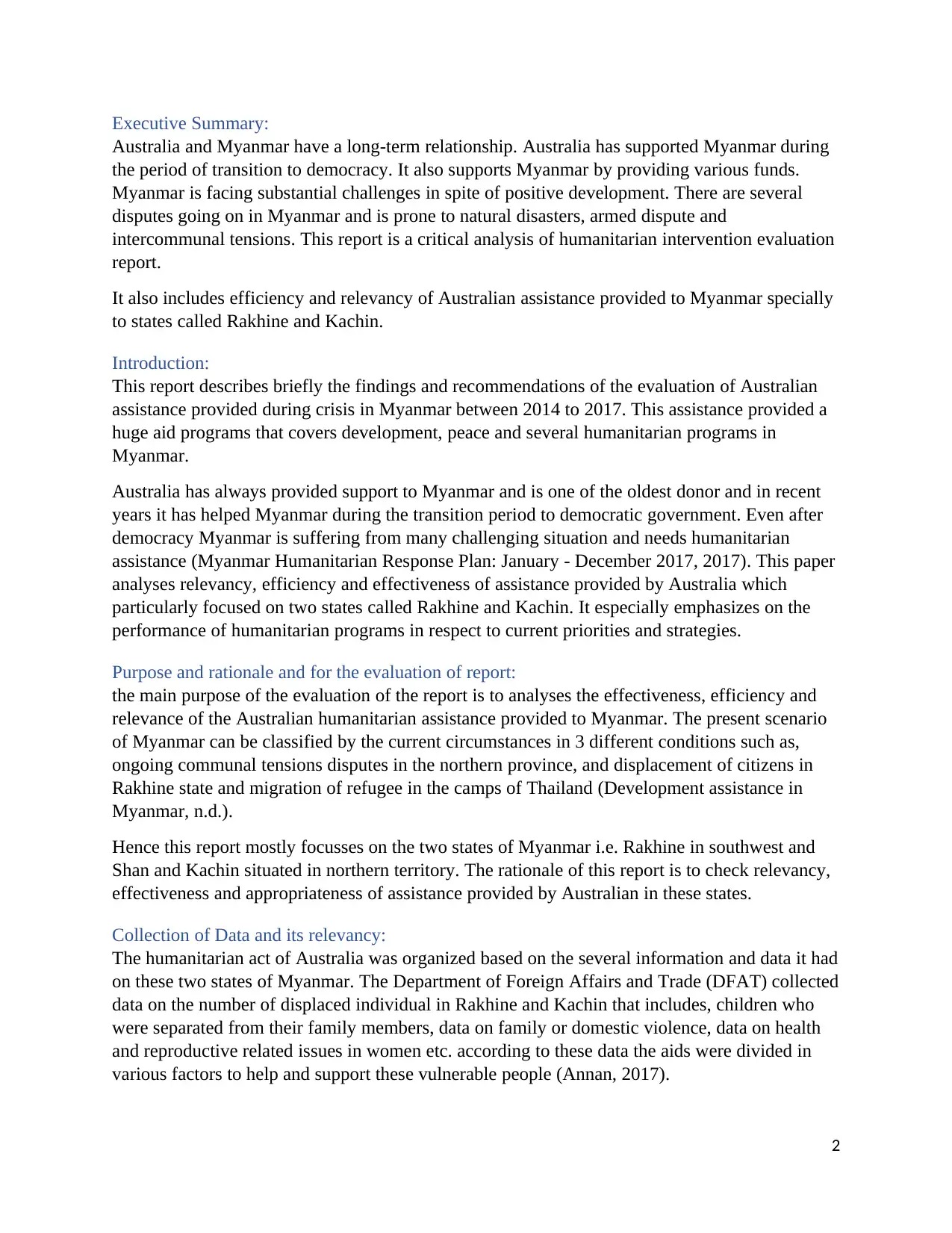
Executive Summary:
Australia and Myanmar have a long-term relationship. Australia has supported Myanmar during
the period of transition to democracy. It also supports Myanmar by providing various funds.
Myanmar is facing substantial challenges in spite of positive development. There are several
disputes going on in Myanmar and is prone to natural disasters, armed dispute and
intercommunal tensions. This report is a critical analysis of humanitarian intervention evaluation
report.
It also includes efficiency and relevancy of Australian assistance provided to Myanmar specially
to states called Rakhine and Kachin.
Introduction:
This report describes briefly the findings and recommendations of the evaluation of Australian
assistance provided during crisis in Myanmar between 2014 to 2017. This assistance provided a
huge aid programs that covers development, peace and several humanitarian programs in
Myanmar.
Australia has always provided support to Myanmar and is one of the oldest donor and in recent
years it has helped Myanmar during the transition period to democratic government. Even after
democracy Myanmar is suffering from many challenging situation and needs humanitarian
assistance (Myanmar Humanitarian Response Plan: January - December 2017, 2017). This paper
analyses relevancy, efficiency and effectiveness of assistance provided by Australia which
particularly focused on two states called Rakhine and Kachin. It especially emphasizes on the
performance of humanitarian programs in respect to current priorities and strategies.
Purpose and rationale and for the evaluation of report:
the main purpose of the evaluation of the report is to analyses the effectiveness, efficiency and
relevance of the Australian humanitarian assistance provided to Myanmar. The present scenario
of Myanmar can be classified by the current circumstances in 3 different conditions such as,
ongoing communal tensions disputes in the northern province, and displacement of citizens in
Rakhine state and migration of refugee in the camps of Thailand (Development assistance in
Myanmar, n.d.).
Hence this report mostly focusses on the two states of Myanmar i.e. Rakhine in southwest and
Shan and Kachin situated in northern territory. The rationale of this report is to check relevancy,
effectiveness and appropriateness of assistance provided by Australian in these states.
Collection of Data and its relevancy:
The humanitarian act of Australia was organized based on the several information and data it had
on these two states of Myanmar. The Department of Foreign Affairs and Trade (DFAT) collected
data on the number of displaced individual in Rakhine and Kachin that includes, children who
were separated from their family members, data on family or domestic violence, data on health
and reproductive related issues in women etc. according to these data the aids were divided in
various factors to help and support these vulnerable people (Annan, 2017).
2
Australia and Myanmar have a long-term relationship. Australia has supported Myanmar during
the period of transition to democracy. It also supports Myanmar by providing various funds.
Myanmar is facing substantial challenges in spite of positive development. There are several
disputes going on in Myanmar and is prone to natural disasters, armed dispute and
intercommunal tensions. This report is a critical analysis of humanitarian intervention evaluation
report.
It also includes efficiency and relevancy of Australian assistance provided to Myanmar specially
to states called Rakhine and Kachin.
Introduction:
This report describes briefly the findings and recommendations of the evaluation of Australian
assistance provided during crisis in Myanmar between 2014 to 2017. This assistance provided a
huge aid programs that covers development, peace and several humanitarian programs in
Myanmar.
Australia has always provided support to Myanmar and is one of the oldest donor and in recent
years it has helped Myanmar during the transition period to democratic government. Even after
democracy Myanmar is suffering from many challenging situation and needs humanitarian
assistance (Myanmar Humanitarian Response Plan: January - December 2017, 2017). This paper
analyses relevancy, efficiency and effectiveness of assistance provided by Australia which
particularly focused on two states called Rakhine and Kachin. It especially emphasizes on the
performance of humanitarian programs in respect to current priorities and strategies.
Purpose and rationale and for the evaluation of report:
the main purpose of the evaluation of the report is to analyses the effectiveness, efficiency and
relevance of the Australian humanitarian assistance provided to Myanmar. The present scenario
of Myanmar can be classified by the current circumstances in 3 different conditions such as,
ongoing communal tensions disputes in the northern province, and displacement of citizens in
Rakhine state and migration of refugee in the camps of Thailand (Development assistance in
Myanmar, n.d.).
Hence this report mostly focusses on the two states of Myanmar i.e. Rakhine in southwest and
Shan and Kachin situated in northern territory. The rationale of this report is to check relevancy,
effectiveness and appropriateness of assistance provided by Australian in these states.
Collection of Data and its relevancy:
The humanitarian act of Australia was organized based on the several information and data it had
on these two states of Myanmar. The Department of Foreign Affairs and Trade (DFAT) collected
data on the number of displaced individual in Rakhine and Kachin that includes, children who
were separated from their family members, data on family or domestic violence, data on health
and reproductive related issues in women etc. according to these data the aids were divided in
various factors to help and support these vulnerable people (Annan, 2017).
2
⊘ This is a preview!⊘
Do you want full access?
Subscribe today to unlock all pages.

Trusted by 1+ million students worldwide
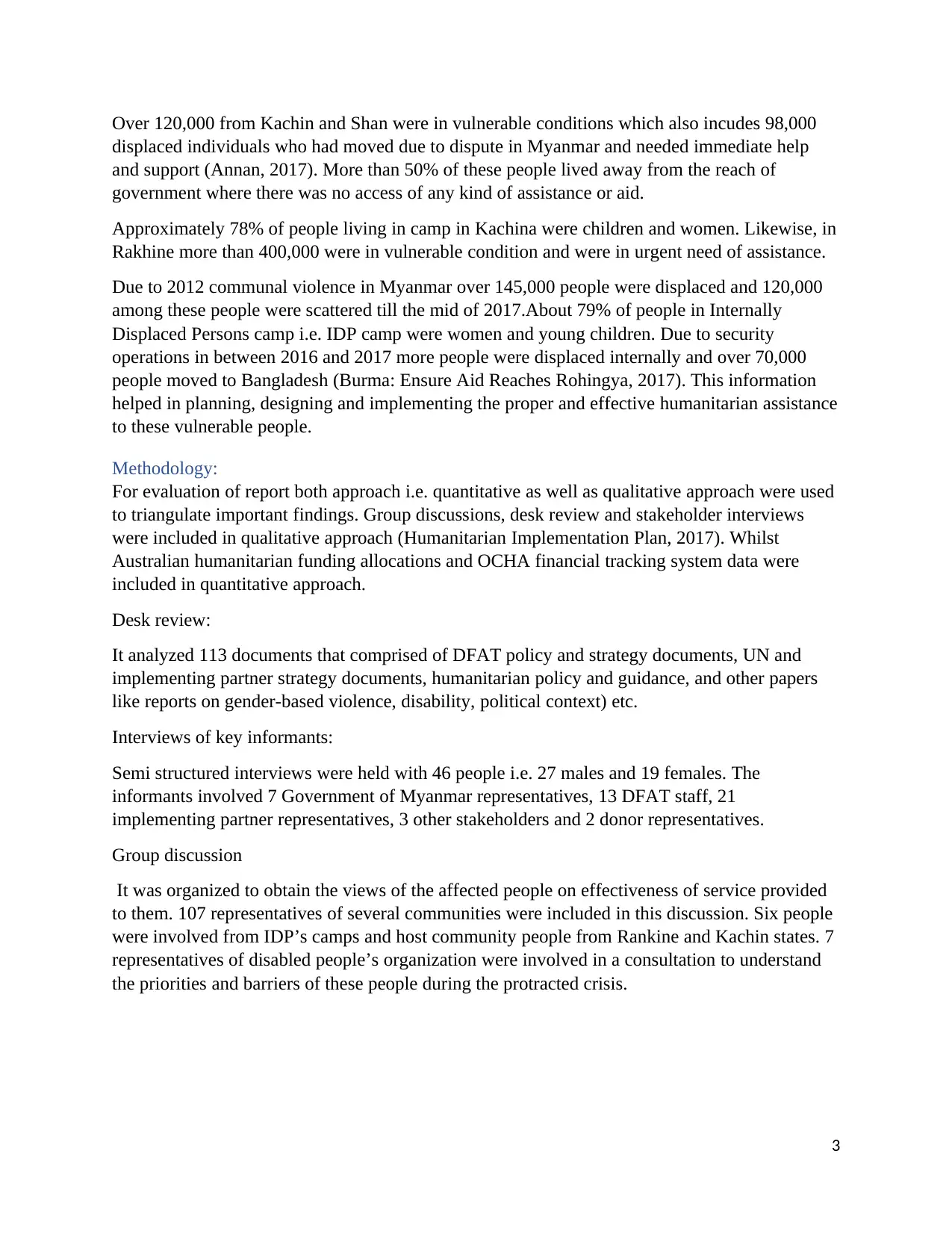
Over 120,000 from Kachin and Shan were in vulnerable conditions which also incudes 98,000
displaced individuals who had moved due to dispute in Myanmar and needed immediate help
and support (Annan, 2017). More than 50% of these people lived away from the reach of
government where there was no access of any kind of assistance or aid.
Approximately 78% of people living in camp in Kachina were children and women. Likewise, in
Rakhine more than 400,000 were in vulnerable condition and were in urgent need of assistance.
Due to 2012 communal violence in Myanmar over 145,000 people were displaced and 120,000
among these people were scattered till the mid of 2017.About 79% of people in Internally
Displaced Persons camp i.e. IDP camp were women and young children. Due to security
operations in between 2016 and 2017 more people were displaced internally and over 70,000
people moved to Bangladesh (Burma: Ensure Aid Reaches Rohingya, 2017). This information
helped in planning, designing and implementing the proper and effective humanitarian assistance
to these vulnerable people.
Methodology:
For evaluation of report both approach i.e. quantitative as well as qualitative approach were used
to triangulate important findings. Group discussions, desk review and stakeholder interviews
were included in qualitative approach (Humanitarian Implementation Plan, 2017). Whilst
Australian humanitarian funding allocations and OCHA financial tracking system data were
included in quantitative approach.
Desk review:
It analyzed 113 documents that comprised of DFAT policy and strategy documents, UN and
implementing partner strategy documents, humanitarian policy and guidance, and other papers
like reports on gender-based violence, disability, political context) etc.
Interviews of key informants:
Semi structured interviews were held with 46 people i.e. 27 males and 19 females. The
informants involved 7 Government of Myanmar representatives, 13 DFAT staff, 21
implementing partner representatives, 3 other stakeholders and 2 donor representatives.
Group discussion
It was organized to obtain the views of the affected people on effectiveness of service provided
to them. 107 representatives of several communities were included in this discussion. Six people
were involved from IDP’s camps and host community people from Rankine and Kachin states. 7
representatives of disabled people’s organization were involved in a consultation to understand
the priorities and barriers of these people during the protracted crisis.
3
displaced individuals who had moved due to dispute in Myanmar and needed immediate help
and support (Annan, 2017). More than 50% of these people lived away from the reach of
government where there was no access of any kind of assistance or aid.
Approximately 78% of people living in camp in Kachina were children and women. Likewise, in
Rakhine more than 400,000 were in vulnerable condition and were in urgent need of assistance.
Due to 2012 communal violence in Myanmar over 145,000 people were displaced and 120,000
among these people were scattered till the mid of 2017.About 79% of people in Internally
Displaced Persons camp i.e. IDP camp were women and young children. Due to security
operations in between 2016 and 2017 more people were displaced internally and over 70,000
people moved to Bangladesh (Burma: Ensure Aid Reaches Rohingya, 2017). This information
helped in planning, designing and implementing the proper and effective humanitarian assistance
to these vulnerable people.
Methodology:
For evaluation of report both approach i.e. quantitative as well as qualitative approach were used
to triangulate important findings. Group discussions, desk review and stakeholder interviews
were included in qualitative approach (Humanitarian Implementation Plan, 2017). Whilst
Australian humanitarian funding allocations and OCHA financial tracking system data were
included in quantitative approach.
Desk review:
It analyzed 113 documents that comprised of DFAT policy and strategy documents, UN and
implementing partner strategy documents, humanitarian policy and guidance, and other papers
like reports on gender-based violence, disability, political context) etc.
Interviews of key informants:
Semi structured interviews were held with 46 people i.e. 27 males and 19 females. The
informants involved 7 Government of Myanmar representatives, 13 DFAT staff, 21
implementing partner representatives, 3 other stakeholders and 2 donor representatives.
Group discussion
It was organized to obtain the views of the affected people on effectiveness of service provided
to them. 107 representatives of several communities were included in this discussion. Six people
were involved from IDP’s camps and host community people from Rankine and Kachin states. 7
representatives of disabled people’s organization were involved in a consultation to understand
the priorities and barriers of these people during the protracted crisis.
3
Paraphrase This Document
Need a fresh take? Get an instant paraphrase of this document with our AI Paraphraser
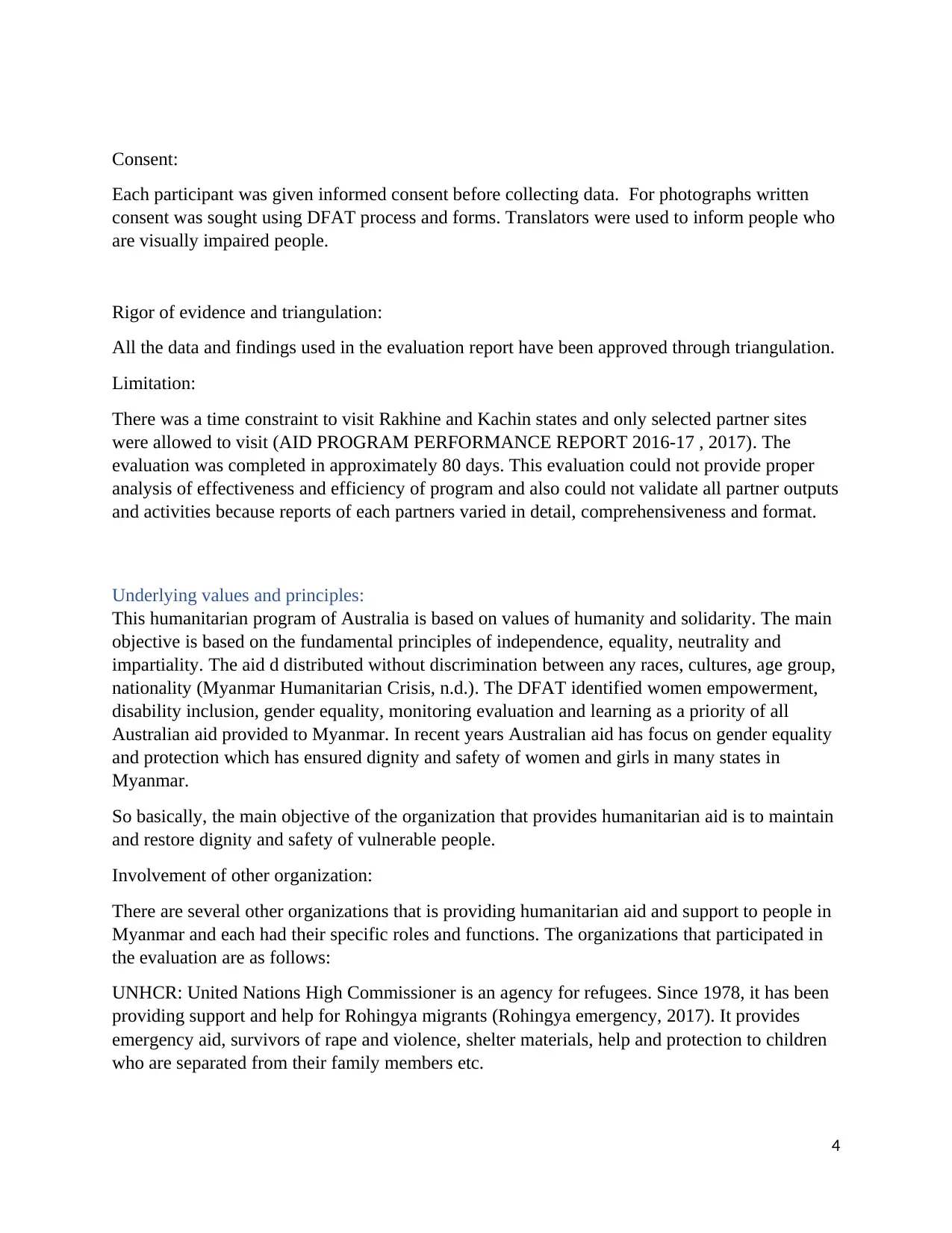
Consent:
Each participant was given informed consent before collecting data. For photographs written
consent was sought using DFAT process and forms. Translators were used to inform people who
are visually impaired people.
Rigor of evidence and triangulation:
All the data and findings used in the evaluation report have been approved through triangulation.
Limitation:
There was a time constraint to visit Rakhine and Kachin states and only selected partner sites
were allowed to visit (AID PROGRAM PERFORMANCE REPORT 2016-17 , 2017). The
evaluation was completed in approximately 80 days. This evaluation could not provide proper
analysis of effectiveness and efficiency of program and also could not validate all partner outputs
and activities because reports of each partners varied in detail, comprehensiveness and format.
Underlying values and principles:
This humanitarian program of Australia is based on values of humanity and solidarity. The main
objective is based on the fundamental principles of independence, equality, neutrality and
impartiality. The aid d distributed without discrimination between any races, cultures, age group,
nationality (Myanmar Humanitarian Crisis, n.d.). The DFAT identified women empowerment,
disability inclusion, gender equality, monitoring evaluation and learning as a priority of all
Australian aid provided to Myanmar. In recent years Australian aid has focus on gender equality
and protection which has ensured dignity and safety of women and girls in many states in
Myanmar.
So basically, the main objective of the organization that provides humanitarian aid is to maintain
and restore dignity and safety of vulnerable people.
Involvement of other organization:
There are several other organizations that is providing humanitarian aid and support to people in
Myanmar and each had their specific roles and functions. The organizations that participated in
the evaluation are as follows:
UNHCR: United Nations High Commissioner is an agency for refugees. Since 1978, it has been
providing support and help for Rohingya migrants (Rohingya emergency, 2017). It provides
emergency aid, survivors of rape and violence, shelter materials, help and protection to children
who are separated from their family members etc.
4
Each participant was given informed consent before collecting data. For photographs written
consent was sought using DFAT process and forms. Translators were used to inform people who
are visually impaired people.
Rigor of evidence and triangulation:
All the data and findings used in the evaluation report have been approved through triangulation.
Limitation:
There was a time constraint to visit Rakhine and Kachin states and only selected partner sites
were allowed to visit (AID PROGRAM PERFORMANCE REPORT 2016-17 , 2017). The
evaluation was completed in approximately 80 days. This evaluation could not provide proper
analysis of effectiveness and efficiency of program and also could not validate all partner outputs
and activities because reports of each partners varied in detail, comprehensiveness and format.
Underlying values and principles:
This humanitarian program of Australia is based on values of humanity and solidarity. The main
objective is based on the fundamental principles of independence, equality, neutrality and
impartiality. The aid d distributed without discrimination between any races, cultures, age group,
nationality (Myanmar Humanitarian Crisis, n.d.). The DFAT identified women empowerment,
disability inclusion, gender equality, monitoring evaluation and learning as a priority of all
Australian aid provided to Myanmar. In recent years Australian aid has focus on gender equality
and protection which has ensured dignity and safety of women and girls in many states in
Myanmar.
So basically, the main objective of the organization that provides humanitarian aid is to maintain
and restore dignity and safety of vulnerable people.
Involvement of other organization:
There are several other organizations that is providing humanitarian aid and support to people in
Myanmar and each had their specific roles and functions. The organizations that participated in
the evaluation are as follows:
UNHCR: United Nations High Commissioner is an agency for refugees. Since 1978, it has been
providing support and help for Rohingya migrants (Rohingya emergency, 2017). It provides
emergency aid, survivors of rape and violence, shelter materials, help and protection to children
who are separated from their family members etc.
4
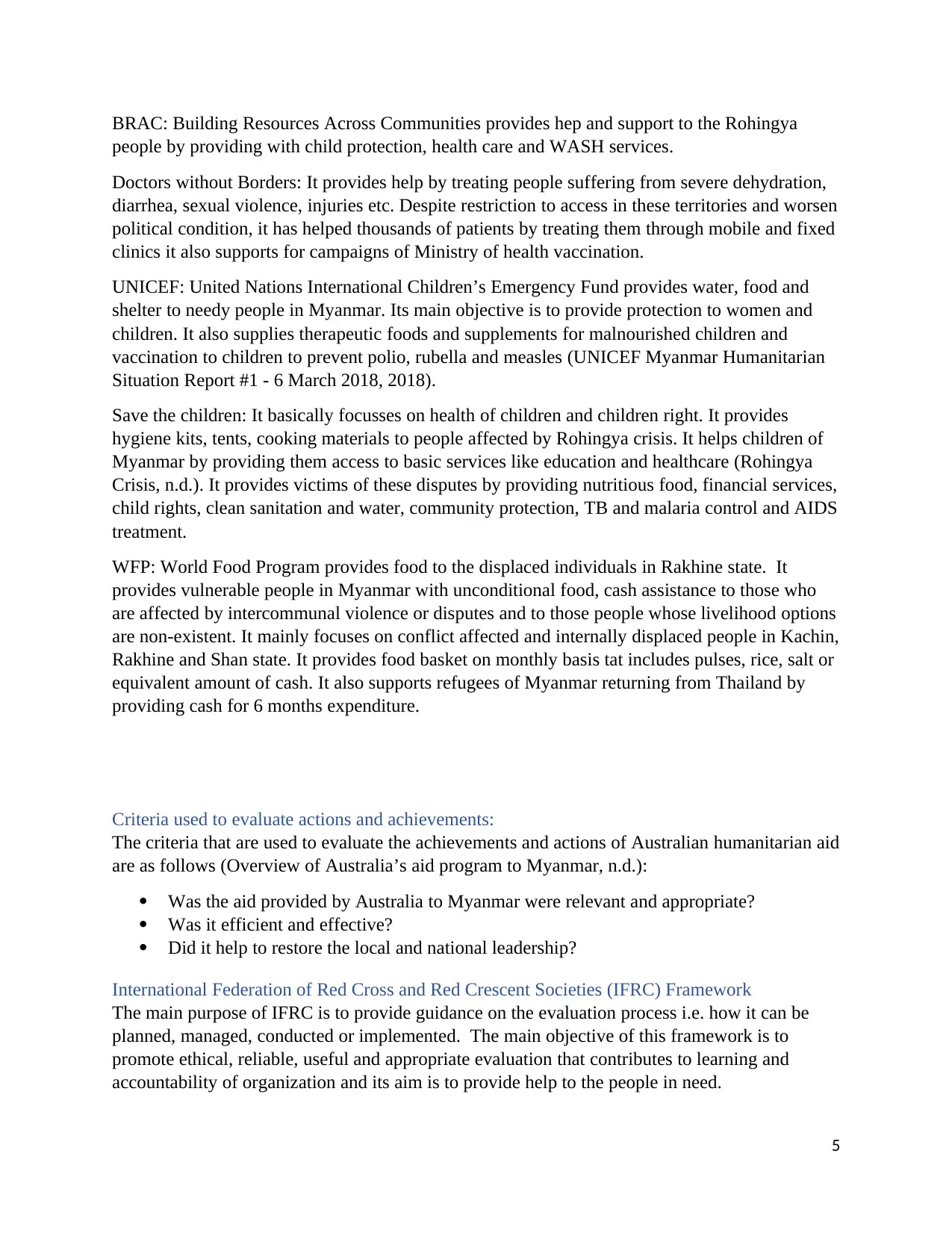
BRAC: Building Resources Across Communities provides hep and support to the Rohingya
people by providing with child protection, health care and WASH services.
Doctors without Borders: It provides help by treating people suffering from severe dehydration,
diarrhea, sexual violence, injuries etc. Despite restriction to access in these territories and worsen
political condition, it has helped thousands of patients by treating them through mobile and fixed
clinics it also supports for campaigns of Ministry of health vaccination.
UNICEF: United Nations International Children’s Emergency Fund provides water, food and
shelter to needy people in Myanmar. Its main objective is to provide protection to women and
children. It also supplies therapeutic foods and supplements for malnourished children and
vaccination to children to prevent polio, rubella and measles (UNICEF Myanmar Humanitarian
Situation Report #1 - 6 March 2018, 2018).
Save the children: It basically focusses on health of children and children right. It provides
hygiene kits, tents, cooking materials to people affected by Rohingya crisis. It helps children of
Myanmar by providing them access to basic services like education and healthcare (Rohingya
Crisis, n.d.). It provides victims of these disputes by providing nutritious food, financial services,
child rights, clean sanitation and water, community protection, TB and malaria control and AIDS
treatment.
WFP: World Food Program provides food to the displaced individuals in Rakhine state. It
provides vulnerable people in Myanmar with unconditional food, cash assistance to those who
are affected by intercommunal violence or disputes and to those people whose livelihood options
are non-existent. It mainly focuses on conflict affected and internally displaced people in Kachin,
Rakhine and Shan state. It provides food basket on monthly basis tat includes pulses, rice, salt or
equivalent amount of cash. It also supports refugees of Myanmar returning from Thailand by
providing cash for 6 months expenditure.
Criteria used to evaluate actions and achievements:
The criteria that are used to evaluate the achievements and actions of Australian humanitarian aid
are as follows (Overview of Australia’s aid program to Myanmar, n.d.):
Was the aid provided by Australia to Myanmar were relevant and appropriate?
Was it efficient and effective?
Did it help to restore the local and national leadership?
International Federation of Red Cross and Red Crescent Societies (IFRC) Framework
The main purpose of IFRC is to provide guidance on the evaluation process i.e. how it can be
planned, managed, conducted or implemented. The main objective of this framework is to
promote ethical, reliable, useful and appropriate evaluation that contributes to learning and
accountability of organization and its aim is to provide help to the people in need.
5
people by providing with child protection, health care and WASH services.
Doctors without Borders: It provides help by treating people suffering from severe dehydration,
diarrhea, sexual violence, injuries etc. Despite restriction to access in these territories and worsen
political condition, it has helped thousands of patients by treating them through mobile and fixed
clinics it also supports for campaigns of Ministry of health vaccination.
UNICEF: United Nations International Children’s Emergency Fund provides water, food and
shelter to needy people in Myanmar. Its main objective is to provide protection to women and
children. It also supplies therapeutic foods and supplements for malnourished children and
vaccination to children to prevent polio, rubella and measles (UNICEF Myanmar Humanitarian
Situation Report #1 - 6 March 2018, 2018).
Save the children: It basically focusses on health of children and children right. It provides
hygiene kits, tents, cooking materials to people affected by Rohingya crisis. It helps children of
Myanmar by providing them access to basic services like education and healthcare (Rohingya
Crisis, n.d.). It provides victims of these disputes by providing nutritious food, financial services,
child rights, clean sanitation and water, community protection, TB and malaria control and AIDS
treatment.
WFP: World Food Program provides food to the displaced individuals in Rakhine state. It
provides vulnerable people in Myanmar with unconditional food, cash assistance to those who
are affected by intercommunal violence or disputes and to those people whose livelihood options
are non-existent. It mainly focuses on conflict affected and internally displaced people in Kachin,
Rakhine and Shan state. It provides food basket on monthly basis tat includes pulses, rice, salt or
equivalent amount of cash. It also supports refugees of Myanmar returning from Thailand by
providing cash for 6 months expenditure.
Criteria used to evaluate actions and achievements:
The criteria that are used to evaluate the achievements and actions of Australian humanitarian aid
are as follows (Overview of Australia’s aid program to Myanmar, n.d.):
Was the aid provided by Australia to Myanmar were relevant and appropriate?
Was it efficient and effective?
Did it help to restore the local and national leadership?
International Federation of Red Cross and Red Crescent Societies (IFRC) Framework
The main purpose of IFRC is to provide guidance on the evaluation process i.e. how it can be
planned, managed, conducted or implemented. The main objective of this framework is to
promote ethical, reliable, useful and appropriate evaluation that contributes to learning and
accountability of organization and its aim is to provide help to the people in need.
5
⊘ This is a preview!⊘
Do you want full access?
Subscribe today to unlock all pages.

Trusted by 1+ million students worldwide
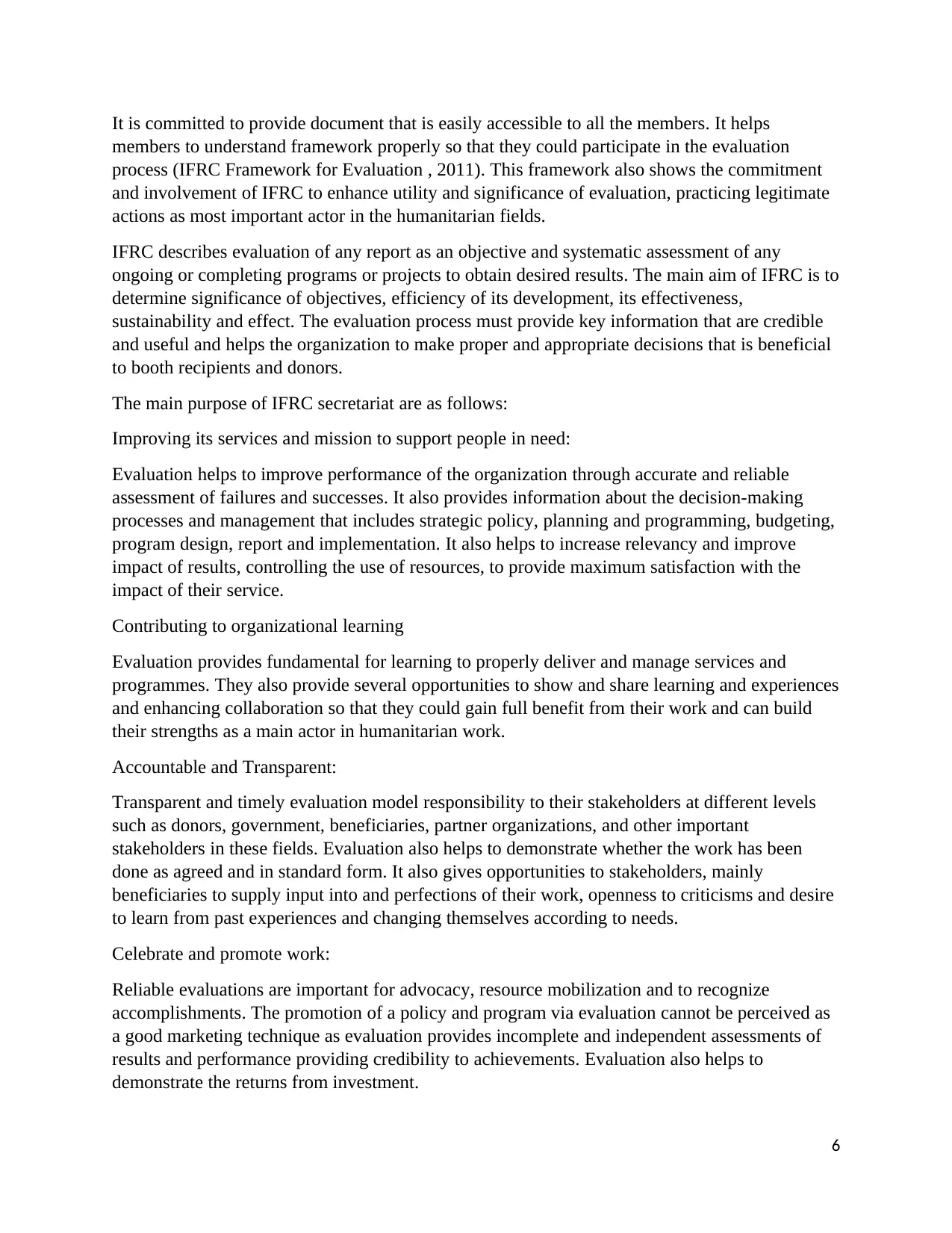
It is committed to provide document that is easily accessible to all the members. It helps
members to understand framework properly so that they could participate in the evaluation
process (IFRC Framework for Evaluation , 2011). This framework also shows the commitment
and involvement of IFRC to enhance utility and significance of evaluation, practicing legitimate
actions as most important actor in the humanitarian fields.
IFRC describes evaluation of any report as an objective and systematic assessment of any
ongoing or completing programs or projects to obtain desired results. The main aim of IFRC is to
determine significance of objectives, efficiency of its development, its effectiveness,
sustainability and effect. The evaluation process must provide key information that are credible
and useful and helps the organization to make proper and appropriate decisions that is beneficial
to booth recipients and donors.
The main purpose of IFRC secretariat are as follows:
Improving its services and mission to support people in need:
Evaluation helps to improve performance of the organization through accurate and reliable
assessment of failures and successes. It also provides information about the decision-making
processes and management that includes strategic policy, planning and programming, budgeting,
program design, report and implementation. It also helps to increase relevancy and improve
impact of results, controlling the use of resources, to provide maximum satisfaction with the
impact of their service.
Contributing to organizational learning
Evaluation provides fundamental for learning to properly deliver and manage services and
programmes. They also provide several opportunities to show and share learning and experiences
and enhancing collaboration so that they could gain full benefit from their work and can build
their strengths as a main actor in humanitarian work.
Accountable and Transparent:
Transparent and timely evaluation model responsibility to their stakeholders at different levels
such as donors, government, beneficiaries, partner organizations, and other important
stakeholders in these fields. Evaluation also helps to demonstrate whether the work has been
done as agreed and in standard form. It also gives opportunities to stakeholders, mainly
beneficiaries to supply input into and perfections of their work, openness to criticisms and desire
to learn from past experiences and changing themselves according to needs.
Celebrate and promote work:
Reliable evaluations are important for advocacy, resource mobilization and to recognize
accomplishments. The promotion of a policy and program via evaluation cannot be perceived as
a good marketing technique as evaluation provides incomplete and independent assessments of
results and performance providing credibility to achievements. Evaluation also helps to
demonstrate the returns from investment.
6
members to understand framework properly so that they could participate in the evaluation
process (IFRC Framework for Evaluation , 2011). This framework also shows the commitment
and involvement of IFRC to enhance utility and significance of evaluation, practicing legitimate
actions as most important actor in the humanitarian fields.
IFRC describes evaluation of any report as an objective and systematic assessment of any
ongoing or completing programs or projects to obtain desired results. The main aim of IFRC is to
determine significance of objectives, efficiency of its development, its effectiveness,
sustainability and effect. The evaluation process must provide key information that are credible
and useful and helps the organization to make proper and appropriate decisions that is beneficial
to booth recipients and donors.
The main purpose of IFRC secretariat are as follows:
Improving its services and mission to support people in need:
Evaluation helps to improve performance of the organization through accurate and reliable
assessment of failures and successes. It also provides information about the decision-making
processes and management that includes strategic policy, planning and programming, budgeting,
program design, report and implementation. It also helps to increase relevancy and improve
impact of results, controlling the use of resources, to provide maximum satisfaction with the
impact of their service.
Contributing to organizational learning
Evaluation provides fundamental for learning to properly deliver and manage services and
programmes. They also provide several opportunities to show and share learning and experiences
and enhancing collaboration so that they could gain full benefit from their work and can build
their strengths as a main actor in humanitarian work.
Accountable and Transparent:
Transparent and timely evaluation model responsibility to their stakeholders at different levels
such as donors, government, beneficiaries, partner organizations, and other important
stakeholders in these fields. Evaluation also helps to demonstrate whether the work has been
done as agreed and in standard form. It also gives opportunities to stakeholders, mainly
beneficiaries to supply input into and perfections of their work, openness to criticisms and desire
to learn from past experiences and changing themselves according to needs.
Celebrate and promote work:
Reliable evaluations are important for advocacy, resource mobilization and to recognize
accomplishments. The promotion of a policy and program via evaluation cannot be perceived as
a good marketing technique as evaluation provides incomplete and independent assessments of
results and performance providing credibility to achievements. Evaluation also helps to
demonstrate the returns from investment.
6
Paraphrase This Document
Need a fresh take? Get an instant paraphrase of this document with our AI Paraphraser
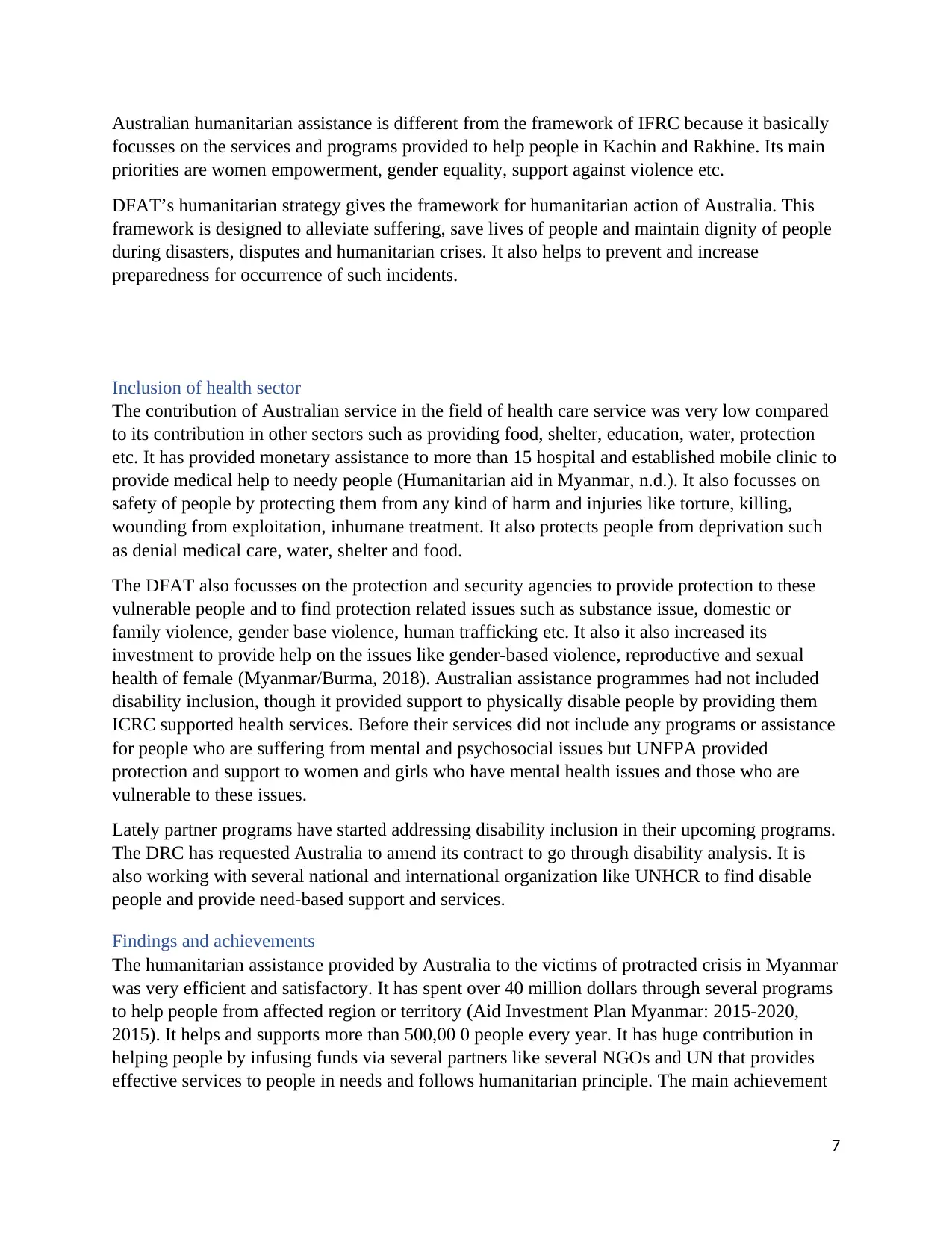
Australian humanitarian assistance is different from the framework of IFRC because it basically
focusses on the services and programs provided to help people in Kachin and Rakhine. Its main
priorities are women empowerment, gender equality, support against violence etc.
DFAT’s humanitarian strategy gives the framework for humanitarian action of Australia. This
framework is designed to alleviate suffering, save lives of people and maintain dignity of people
during disasters, disputes and humanitarian crises. It also helps to prevent and increase
preparedness for occurrence of such incidents.
Inclusion of health sector
The contribution of Australian service in the field of health care service was very low compared
to its contribution in other sectors such as providing food, shelter, education, water, protection
etc. It has provided monetary assistance to more than 15 hospital and established mobile clinic to
provide medical help to needy people (Humanitarian aid in Myanmar, n.d.). It also focusses on
safety of people by protecting them from any kind of harm and injuries like torture, killing,
wounding from exploitation, inhumane treatment. It also protects people from deprivation such
as denial medical care, water, shelter and food.
The DFAT also focusses on the protection and security agencies to provide protection to these
vulnerable people and to find protection related issues such as substance issue, domestic or
family violence, gender base violence, human trafficking etc. It also it also increased its
investment to provide help on the issues like gender-based violence, reproductive and sexual
health of female (Myanmar/Burma, 2018). Australian assistance programmes had not included
disability inclusion, though it provided support to physically disable people by providing them
ICRC supported health services. Before their services did not include any programs or assistance
for people who are suffering from mental and psychosocial issues but UNFPA provided
protection and support to women and girls who have mental health issues and those who are
vulnerable to these issues.
Lately partner programs have started addressing disability inclusion in their upcoming programs.
The DRC has requested Australia to amend its contract to go through disability analysis. It is
also working with several national and international organization like UNHCR to find disable
people and provide need-based support and services.
Findings and achievements
The humanitarian assistance provided by Australia to the victims of protracted crisis in Myanmar
was very efficient and satisfactory. It has spent over 40 million dollars through several programs
to help people from affected region or territory (Aid Investment Plan Myanmar: 2015-2020,
2015). It helps and supports more than 500,00 0 people every year. It has huge contribution in
helping people by infusing funds via several partners like several NGOs and UN that provides
effective services to people in needs and follows humanitarian principle. The main achievement
7
focusses on the services and programs provided to help people in Kachin and Rakhine. Its main
priorities are women empowerment, gender equality, support against violence etc.
DFAT’s humanitarian strategy gives the framework for humanitarian action of Australia. This
framework is designed to alleviate suffering, save lives of people and maintain dignity of people
during disasters, disputes and humanitarian crises. It also helps to prevent and increase
preparedness for occurrence of such incidents.
Inclusion of health sector
The contribution of Australian service in the field of health care service was very low compared
to its contribution in other sectors such as providing food, shelter, education, water, protection
etc. It has provided monetary assistance to more than 15 hospital and established mobile clinic to
provide medical help to needy people (Humanitarian aid in Myanmar, n.d.). It also focusses on
safety of people by protecting them from any kind of harm and injuries like torture, killing,
wounding from exploitation, inhumane treatment. It also protects people from deprivation such
as denial medical care, water, shelter and food.
The DFAT also focusses on the protection and security agencies to provide protection to these
vulnerable people and to find protection related issues such as substance issue, domestic or
family violence, gender base violence, human trafficking etc. It also it also increased its
investment to provide help on the issues like gender-based violence, reproductive and sexual
health of female (Myanmar/Burma, 2018). Australian assistance programmes had not included
disability inclusion, though it provided support to physically disable people by providing them
ICRC supported health services. Before their services did not include any programs or assistance
for people who are suffering from mental and psychosocial issues but UNFPA provided
protection and support to women and girls who have mental health issues and those who are
vulnerable to these issues.
Lately partner programs have started addressing disability inclusion in their upcoming programs.
The DRC has requested Australia to amend its contract to go through disability analysis. It is
also working with several national and international organization like UNHCR to find disable
people and provide need-based support and services.
Findings and achievements
The humanitarian assistance provided by Australia to the victims of protracted crisis in Myanmar
was very efficient and satisfactory. It has spent over 40 million dollars through several programs
to help people from affected region or territory (Aid Investment Plan Myanmar: 2015-2020,
2015). It helps and supports more than 500,00 0 people every year. It has huge contribution in
helping people by infusing funds via several partners like several NGOs and UN that provides
effective services to people in needs and follows humanitarian principle. The main achievement
7
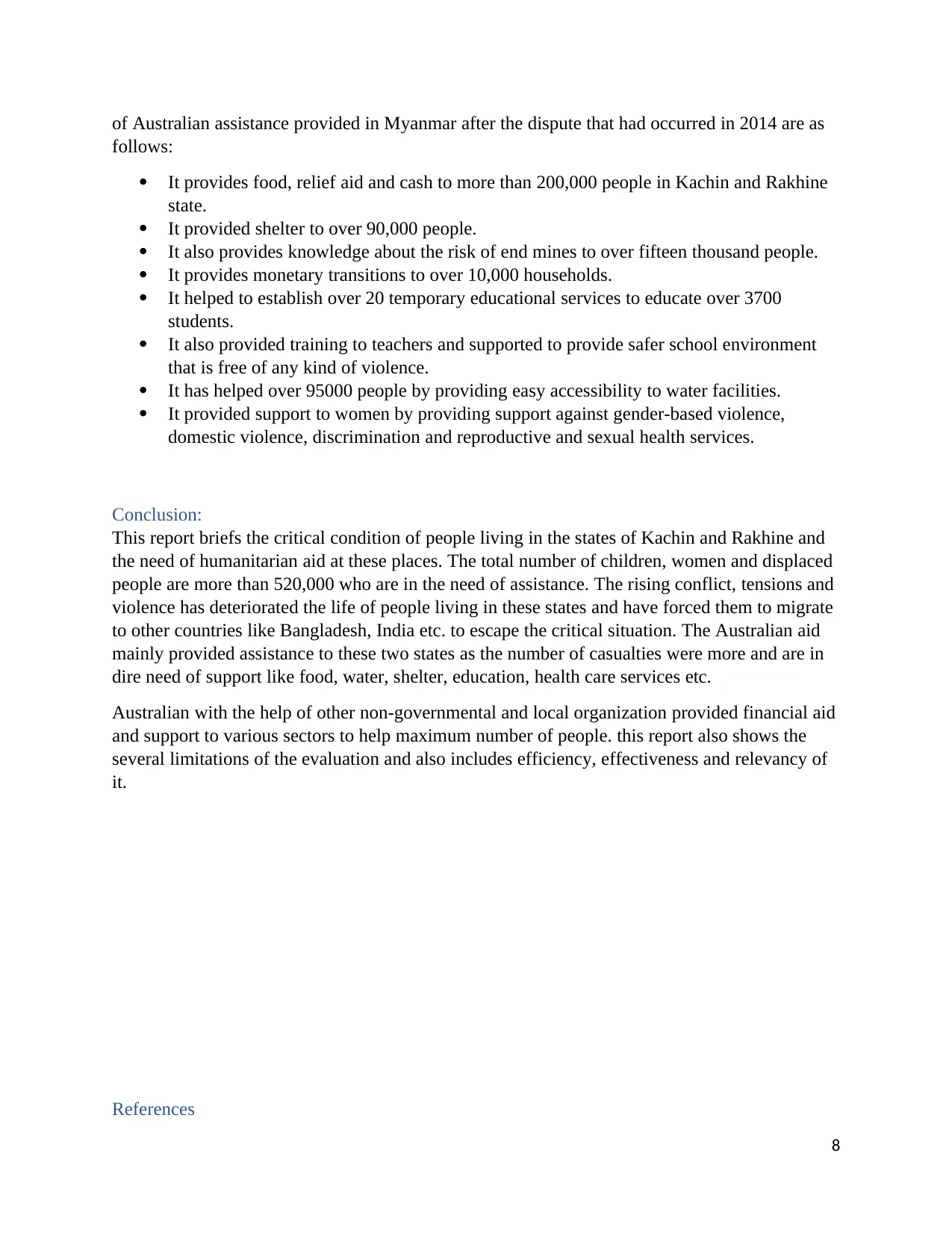
of Australian assistance provided in Myanmar after the dispute that had occurred in 2014 are as
follows:
It provides food, relief aid and cash to more than 200,000 people in Kachin and Rakhine
state.
It provided shelter to over 90,000 people.
It also provides knowledge about the risk of end mines to over fifteen thousand people.
It provides monetary transitions to over 10,000 households.
It helped to establish over 20 temporary educational services to educate over 3700
students.
It also provided training to teachers and supported to provide safer school environment
that is free of any kind of violence.
It has helped over 95000 people by providing easy accessibility to water facilities.
It provided support to women by providing support against gender-based violence,
domestic violence, discrimination and reproductive and sexual health services.
Conclusion:
This report briefs the critical condition of people living in the states of Kachin and Rakhine and
the need of humanitarian aid at these places. The total number of children, women and displaced
people are more than 520,000 who are in the need of assistance. The rising conflict, tensions and
violence has deteriorated the life of people living in these states and have forced them to migrate
to other countries like Bangladesh, India etc. to escape the critical situation. The Australian aid
mainly provided assistance to these two states as the number of casualties were more and are in
dire need of support like food, water, shelter, education, health care services etc.
Australian with the help of other non-governmental and local organization provided financial aid
and support to various sectors to help maximum number of people. this report also shows the
several limitations of the evaluation and also includes efficiency, effectiveness and relevancy of
it.
References
8
follows:
It provides food, relief aid and cash to more than 200,000 people in Kachin and Rakhine
state.
It provided shelter to over 90,000 people.
It also provides knowledge about the risk of end mines to over fifteen thousand people.
It provides monetary transitions to over 10,000 households.
It helped to establish over 20 temporary educational services to educate over 3700
students.
It also provided training to teachers and supported to provide safer school environment
that is free of any kind of violence.
It has helped over 95000 people by providing easy accessibility to water facilities.
It provided support to women by providing support against gender-based violence,
domestic violence, discrimination and reproductive and sexual health services.
Conclusion:
This report briefs the critical condition of people living in the states of Kachin and Rakhine and
the need of humanitarian aid at these places. The total number of children, women and displaced
people are more than 520,000 who are in the need of assistance. The rising conflict, tensions and
violence has deteriorated the life of people living in these states and have forced them to migrate
to other countries like Bangladesh, India etc. to escape the critical situation. The Australian aid
mainly provided assistance to these two states as the number of casualties were more and are in
dire need of support like food, water, shelter, education, health care services etc.
Australian with the help of other non-governmental and local organization provided financial aid
and support to various sectors to help maximum number of people. this report also shows the
several limitations of the evaluation and also includes efficiency, effectiveness and relevancy of
it.
References
8
⊘ This is a preview!⊘
Do you want full access?
Subscribe today to unlock all pages.

Trusted by 1+ million students worldwide
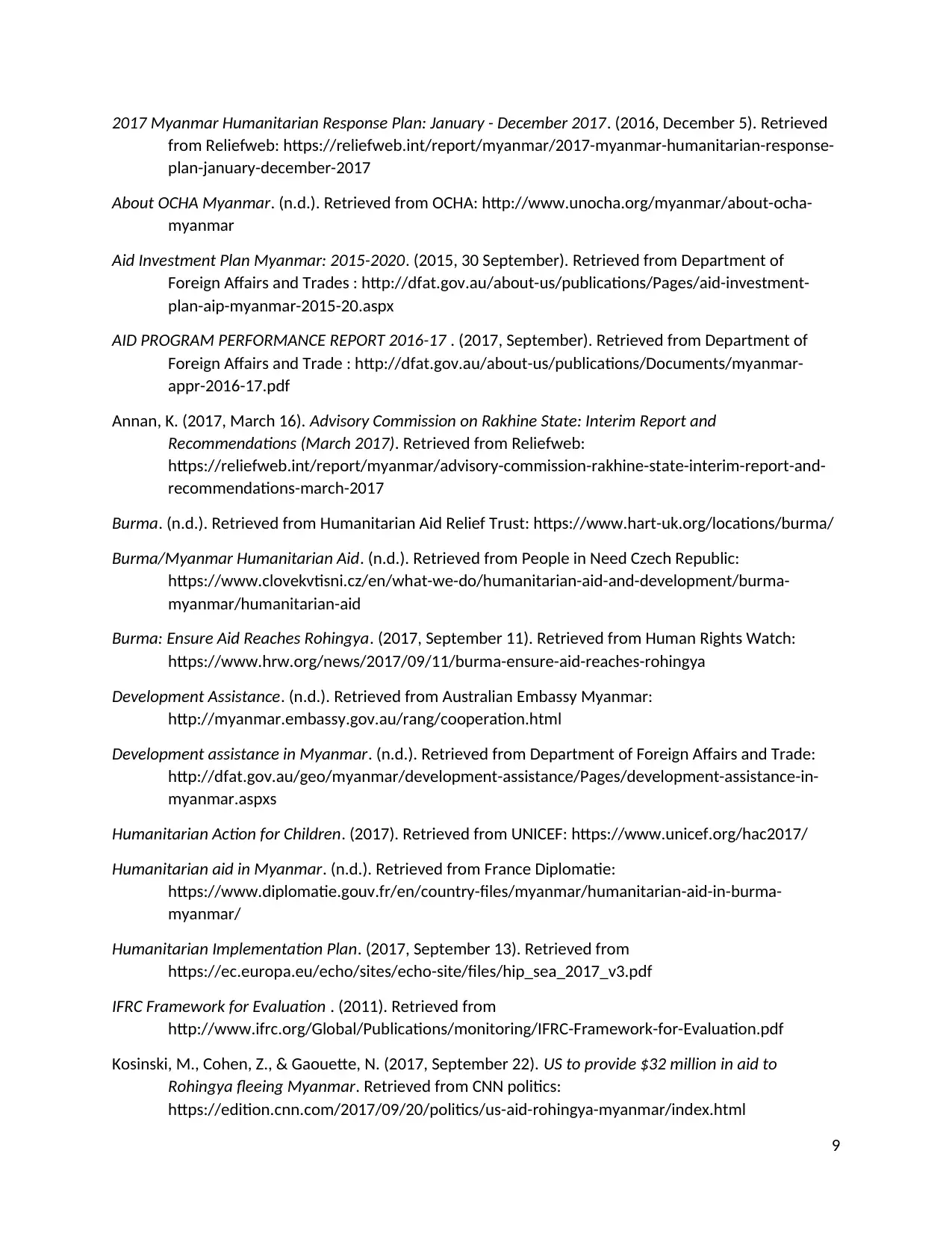
2017 Myanmar Humanitarian Response Plan: January - December 2017. (2016, December 5). Retrieved
from Reliefweb: https://reliefweb.int/report/myanmar/2017-myanmar-humanitarian-response-
plan-january-december-2017
About OCHA Myanmar. (n.d.). Retrieved from OCHA: http://www.unocha.org/myanmar/about-ocha-
myanmar
Aid Investment Plan Myanmar: 2015-2020. (2015, 30 September). Retrieved from Department of
Foreign Affairs and Trades : http://dfat.gov.au/about-us/publications/Pages/aid-investment-
plan-aip-myanmar-2015-20.aspx
AID PROGRAM PERFORMANCE REPORT 2016-17 . (2017, September). Retrieved from Department of
Foreign Affairs and Trade : http://dfat.gov.au/about-us/publications/Documents/myanmar-
appr-2016-17.pdf
Annan, K. (2017, March 16). Advisory Commission on Rakhine State: Interim Report and
Recommendations (March 2017). Retrieved from Reliefweb:
https://reliefweb.int/report/myanmar/advisory-commission-rakhine-state-interim-report-and-
recommendations-march-2017
Burma. (n.d.). Retrieved from Humanitarian Aid Relief Trust: https://www.hart-uk.org/locations/burma/
Burma/Myanmar Humanitarian Aid. (n.d.). Retrieved from People in Need Czech Republic:
https://www.clovekvtisni.cz/en/what-we-do/humanitarian-aid-and-development/burma-
myanmar/humanitarian-aid
Burma: Ensure Aid Reaches Rohingya. (2017, September 11). Retrieved from Human Rights Watch:
https://www.hrw.org/news/2017/09/11/burma-ensure-aid-reaches-rohingya
Development Assistance. (n.d.). Retrieved from Australian Embassy Myanmar:
http://myanmar.embassy.gov.au/rang/cooperation.html
Development assistance in Myanmar. (n.d.). Retrieved from Department of Foreign Affairs and Trade:
http://dfat.gov.au/geo/myanmar/development-assistance/Pages/development-assistance-in-
myanmar.aspxs
Humanitarian Action for Children. (2017). Retrieved from UNICEF: https://www.unicef.org/hac2017/
Humanitarian aid in Myanmar. (n.d.). Retrieved from France Diplomatie:
https://www.diplomatie.gouv.fr/en/country-files/myanmar/humanitarian-aid-in-burma-
myanmar/
Humanitarian Implementation Plan. (2017, September 13). Retrieved from
https://ec.europa.eu/echo/sites/echo-site/files/hip_sea_2017_v3.pdf
IFRC Framework for Evaluation . (2011). Retrieved from
http://www.ifrc.org/Global/Publications/monitoring/IFRC-Framework-for-Evaluation.pdf
Kosinski, M., Cohen, Z., & Gaouette, N. (2017, September 22). US to provide $32 million in aid to
Rohingya fleeing Myanmar. Retrieved from CNN politics:
https://edition.cnn.com/2017/09/20/politics/us-aid-rohingya-myanmar/index.html
9
from Reliefweb: https://reliefweb.int/report/myanmar/2017-myanmar-humanitarian-response-
plan-january-december-2017
About OCHA Myanmar. (n.d.). Retrieved from OCHA: http://www.unocha.org/myanmar/about-ocha-
myanmar
Aid Investment Plan Myanmar: 2015-2020. (2015, 30 September). Retrieved from Department of
Foreign Affairs and Trades : http://dfat.gov.au/about-us/publications/Pages/aid-investment-
plan-aip-myanmar-2015-20.aspx
AID PROGRAM PERFORMANCE REPORT 2016-17 . (2017, September). Retrieved from Department of
Foreign Affairs and Trade : http://dfat.gov.au/about-us/publications/Documents/myanmar-
appr-2016-17.pdf
Annan, K. (2017, March 16). Advisory Commission on Rakhine State: Interim Report and
Recommendations (March 2017). Retrieved from Reliefweb:
https://reliefweb.int/report/myanmar/advisory-commission-rakhine-state-interim-report-and-
recommendations-march-2017
Burma. (n.d.). Retrieved from Humanitarian Aid Relief Trust: https://www.hart-uk.org/locations/burma/
Burma/Myanmar Humanitarian Aid. (n.d.). Retrieved from People in Need Czech Republic:
https://www.clovekvtisni.cz/en/what-we-do/humanitarian-aid-and-development/burma-
myanmar/humanitarian-aid
Burma: Ensure Aid Reaches Rohingya. (2017, September 11). Retrieved from Human Rights Watch:
https://www.hrw.org/news/2017/09/11/burma-ensure-aid-reaches-rohingya
Development Assistance. (n.d.). Retrieved from Australian Embassy Myanmar:
http://myanmar.embassy.gov.au/rang/cooperation.html
Development assistance in Myanmar. (n.d.). Retrieved from Department of Foreign Affairs and Trade:
http://dfat.gov.au/geo/myanmar/development-assistance/Pages/development-assistance-in-
myanmar.aspxs
Humanitarian Action for Children. (2017). Retrieved from UNICEF: https://www.unicef.org/hac2017/
Humanitarian aid in Myanmar. (n.d.). Retrieved from France Diplomatie:
https://www.diplomatie.gouv.fr/en/country-files/myanmar/humanitarian-aid-in-burma-
myanmar/
Humanitarian Implementation Plan. (2017, September 13). Retrieved from
https://ec.europa.eu/echo/sites/echo-site/files/hip_sea_2017_v3.pdf
IFRC Framework for Evaluation . (2011). Retrieved from
http://www.ifrc.org/Global/Publications/monitoring/IFRC-Framework-for-Evaluation.pdf
Kosinski, M., Cohen, Z., & Gaouette, N. (2017, September 22). US to provide $32 million in aid to
Rohingya fleeing Myanmar. Retrieved from CNN politics:
https://edition.cnn.com/2017/09/20/politics/us-aid-rohingya-myanmar/index.html
9
Paraphrase This Document
Need a fresh take? Get an instant paraphrase of this document with our AI Paraphraser
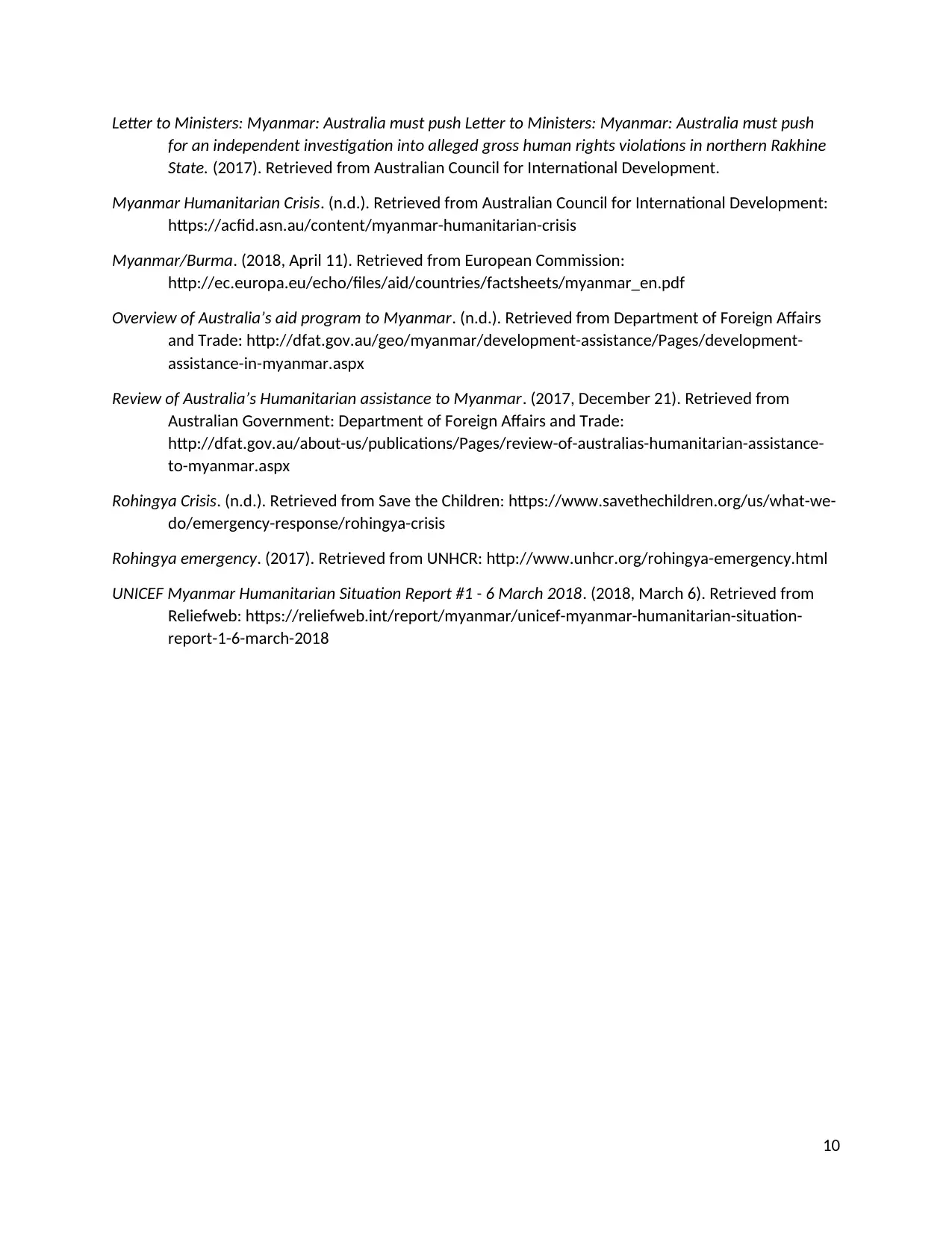
Letter to Ministers: Myanmar: Australia must push Letter to Ministers: Myanmar: Australia must push
for an independent investigation into alleged gross human rights violations in northern Rakhine
State. (2017). Retrieved from Australian Council for International Development.
Myanmar Humanitarian Crisis. (n.d.). Retrieved from Australian Council for International Development:
https://acfid.asn.au/content/myanmar-humanitarian-crisis
Myanmar/Burma. (2018, April 11). Retrieved from European Commission:
http://ec.europa.eu/echo/files/aid/countries/factsheets/myanmar_en.pdf
Overview of Australia’s aid program to Myanmar. (n.d.). Retrieved from Department of Foreign Affairs
and Trade: http://dfat.gov.au/geo/myanmar/development-assistance/Pages/development-
assistance-in-myanmar.aspx
Review of Australia’s Humanitarian assistance to Myanmar. (2017, December 21). Retrieved from
Australian Government: Department of Foreign Affairs and Trade:
http://dfat.gov.au/about-us/publications/Pages/review-of-australias-humanitarian-assistance-
to-myanmar.aspx
Rohingya Crisis. (n.d.). Retrieved from Save the Children: https://www.savethechildren.org/us/what-we-
do/emergency-response/rohingya-crisis
Rohingya emergency. (2017). Retrieved from UNHCR: http://www.unhcr.org/rohingya-emergency.html
UNICEF Myanmar Humanitarian Situation Report #1 - 6 March 2018. (2018, March 6). Retrieved from
Reliefweb: https://reliefweb.int/report/myanmar/unicef-myanmar-humanitarian-situation-
report-1-6-march-2018
10
for an independent investigation into alleged gross human rights violations in northern Rakhine
State. (2017). Retrieved from Australian Council for International Development.
Myanmar Humanitarian Crisis. (n.d.). Retrieved from Australian Council for International Development:
https://acfid.asn.au/content/myanmar-humanitarian-crisis
Myanmar/Burma. (2018, April 11). Retrieved from European Commission:
http://ec.europa.eu/echo/files/aid/countries/factsheets/myanmar_en.pdf
Overview of Australia’s aid program to Myanmar. (n.d.). Retrieved from Department of Foreign Affairs
and Trade: http://dfat.gov.au/geo/myanmar/development-assistance/Pages/development-
assistance-in-myanmar.aspx
Review of Australia’s Humanitarian assistance to Myanmar. (2017, December 21). Retrieved from
Australian Government: Department of Foreign Affairs and Trade:
http://dfat.gov.au/about-us/publications/Pages/review-of-australias-humanitarian-assistance-
to-myanmar.aspx
Rohingya Crisis. (n.d.). Retrieved from Save the Children: https://www.savethechildren.org/us/what-we-
do/emergency-response/rohingya-crisis
Rohingya emergency. (2017). Retrieved from UNHCR: http://www.unhcr.org/rohingya-emergency.html
UNICEF Myanmar Humanitarian Situation Report #1 - 6 March 2018. (2018, March 6). Retrieved from
Reliefweb: https://reliefweb.int/report/myanmar/unicef-myanmar-humanitarian-situation-
report-1-6-march-2018
10
1 out of 11
Related Documents
Your All-in-One AI-Powered Toolkit for Academic Success.
+13062052269
info@desklib.com
Available 24*7 on WhatsApp / Email
![[object Object]](/_next/static/media/star-bottom.7253800d.svg)
Unlock your academic potential
Copyright © 2020–2025 A2Z Services. All Rights Reserved. Developed and managed by ZUCOL.




